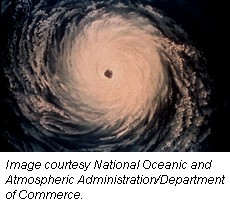We are now in the middle of the 2011 hurricane season. Hurricane Irene recently stormed across the Atlantic, hitting the Bahamas and the Eastern seaboard of the US. Another storm is currently forming off the coast of Africa and has a 70% chance of becoming a tropical depression within the next 48 hours. If you live or work in areas prone to hurricane activity, there is only one question to ask. Are you ready?
Do you have a Hurricane Preparedness Kit? If not, FEMA has a checklist of Recommended Items to Include in a Basic Emergency Supply Kit so you can build your own.
The first two items on FEMA's list are obviously the most critical: water and food, in that order. The third item on the list? A Battery-powered or hand crank radio and a NOAA Weather Radio with tone alert and extra batteries for both.
Radios that meet the requirements suggested in FEMA's list include the following:
Two Way Radios
Midland GXT1000VP4 Radios With Headsets and Charger - The GXT1000VP4 is a powerful 5 watt radio designed for use in all types of weather. It is durable, water resistant, supports NOAA weather channels, NOAA weather alerts and includes a 3 year manufacturer warranty.
Motorola TALKABOUT MS350R Two Way Radios - The MS350R is a brand new high performance radio from Motorola. The MS350R is designed specifically for use in extreme weather conditions. It also features 11 weather channels and a built-in flashlight. The MS350R operates on rechargeable and disposable batteries, is submersible and also floats. The package even includes an Emergency Preparedness Checklist Sheet.
Motorola TALKABOUT T9680R-SAME Two Way Radios - The Motorola T9680R is one of Motorola's most powerful consumer two way radios. It is built as a Hazard Alert radio and features Specific Area Message Encoding (SAME) technology, adopted by the National Weather Service to alert the public to emergency events in their specific area. SAME monitors the NOAA weather stations for you pro-actively and alerts you to emergency weather and hazard conditions. Like the MS350R, The T9680R operates on both rechargeable and alkaline batteries.
Midland XT511 Base Camp Two Way/Emergency Crank Radio - The Midland XT511 is a powerful, all-in-one two way radio that is the perfect choice for any emergency kit. It is, for all intents and purposes, the "Swiss army knife" of radios. It features an FRS/GMRS radio, flashlight, an AM/FM clock radio with an alarm, and NOAA weather alerts. The Midland XT511 offers five power options, including an AC wall power adapter, DC vehicle adapter, rechargeable battery pack, alkaline batteries and can be powered and charged using the Dynamo hand crank. The XT511 also includes a USB connector so you to charge your USB enabled devices (including many cell phones) in case of a power outage.
NOAA Weather Radios (receive only)
Midland WR-120 Weather Radio - The WR-120 is a basic All Hazards Alert weather radio and supports the Public Alert system and SAME technology. When a weather or civil emergency alert is issued in your specific area , an alarm goes off and a text alert is displayed. The WR-120 also features an alarm clock with snooze, a blue backlit display, battery backup, color coded alert light, and external antenna jack. The WR-120 is also tri-lingual and supports English, Spanish or French languages.
Midland WR-300 Weather Radio - The WR-300 offers many of the same features as the WR-120. In addition the WR-300 allows you to choose between an alarm alert, an LED alert, or both.
Midland HH54VP2 SAME Handheld Weather Radio - The Midland HH54VP2 is a small, portable handheld radio ideal for use when travelling. The HH54VP2 supports all NWS hazard alerts utilizing S.A.M.E. technology. The HH-54VP2 also provides other emergency alerts such as Amber Alerts, biological hazard warnings, civil emergency messages, nuclear power plant warnings, fire warnings and landslide warnings. The HH-54VP2 also features an alarm clock with snooze, a large, backlit display with continuous backlighting option, user selectable alerts, color coded alert indicators, and battery backup.
Midland HH-50 Pocket Weather Alert Radio - The Midland HH-50 is an extremely compact weather radio that easily fits in your pocket and auto scans for emergency and weather alerts from the moment you turn it on. The HH-50 supports all hazard alerts issued by the National Weather Service as well as other types of emergency alerts, messages and warnings. Its extremely low cost, light weight and small footprint make it a good choice for a small emergency kit in the car or on the go.
Whether at home or away, on land or water, a radio is an indispensable item for any emergency preparedness kit. When a weather emergency hits your area, alerts and updates on ever changing weather conditions can be vital to your safety or survival. Two way radio communications can also be critical in such emergencies, especially if you lose your landline, cell phone service or power. For more information on emergency weather radios, listen to The Two Way Radio Show Episode 13 - Emergency and Weather Radios.
Don't be caught off guard during the next weather alert. Assemble your Hurricane Preparedness Kit now.
UPDATE: We now carry a complete line of emergency preparedness and survival kits, including the Emergency Zone Severe Weather Emergency Kit. Add your choice of two way radio and be ready for an emergency or weather disaster now!





 Today is June 1, 2011. While today may seem to be of little significance to the average person, the first day of June is an important marker for folks along the Gulf coast and across the eastern seaboard of the United States. Today marks the official start of the 2011 hurricane season.
Today is June 1, 2011. While today may seem to be of little significance to the average person, the first day of June is an important marker for folks along the Gulf coast and across the eastern seaboard of the United States. Today marks the official start of the 2011 hurricane season.
